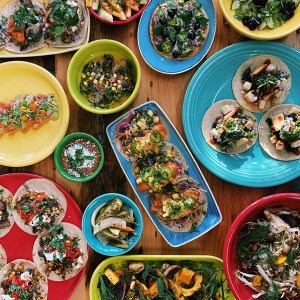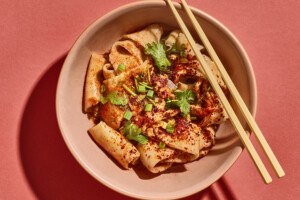Dining Out: Cattle Call
Maybe in the heart of every right-minded diner there lurks an insatiable carnivore. Few things, after all, are more satisfying than ripping into a luscious hunk of meat. Ken Oringer and Jamie Bissonnette have done everything in their power to make the meat luscious at the new KO Prime, where Oringer is owner and consulting chef, and Bissonnette is chef de cuisine. Specifically, they are basting most of it with fat—in many cases, melted bone marrow, about the fattiest fat there is. Steeping the meat in its own fat, a quick version of duck confit—an idea that first seduced and startled me as practiced by Pino Maffeo at Restaurant L—is often unnecessary, and shouldn’t be as good as it almost always is. (By the way, Restaurant L is now a steakhouse, too! Everyone’s getting in on the act. See our story “Year of the Cow.”)
The news that Oringer, master of raw fish and tapas, would open up a fancy hotel steakhouse in a part of downtown where beefy cuts are muscling in everywhere sounded like cashing in on a craze. And particularly unwelcome news, given what it replaced: Spire, an original and welcome addition to the Boston dining scene in the well-located boutique hotel Nine Zero. That restaurant also gave full rein to an important new talent, Gabriel Frasca, who has since moved with the similarly stellar Amanda Lydon to take over Nantucket’s Straight Wharf.
But all is not lost. Spire was limping along after Frasca departed, serving his menu with wan heart; it needed fresh life. And Oringer, who at least hasn’t left town to follow in the footsteps of other ambitious culinary stars, has picked a chef with a local track record and a real feel for meat. At Eastern Standard, where Bissonnette was opening chef, everything besides the meat dishes felt like an afterthought. Overseeing a steakhouse seems a natural step for him.
Though the space is the same—a boxy room with a somewhat low ceiling—the décor at KO Prime is less pretty and stylish than its predecessor’s. The chairs are covered in leather in colors that evoke cigars; carpets of sewn-together peltlike squares look alarmingly animalistic. Service continues to be a strong suit here: There are many people at the check stand, and when you get holdover waiters from Spire you are in expert hands. The general idea seems to be, We’re charging a lot more now, so we have to look serious.
The prices are uniformly high, the meat uniformly tender and great to look at, and the portions big to huge. Through it all, Bissonnette’s pleasure in working with meat is obvious. It comes into perhaps its sharpest focus in his appetizer plate of charcuterie ($12). The day I ordered it there was duck prosciutto, duck offal sausage, and head cheese; all of it was on the sweet side (“Like pancakes!” a guest said in delight at a slice of the sausage, sweet from Sauternes) but demonstrated integrity and expertise.
When KO Prime goes right, the meat is as good as anything in town. The best dishes I tried at two lunches (in which I challenged the kitchen by ordering from the dinner menu; the chef graciously complied) succeeded because of the sheer flavor of the meat. The New York strip ($39) outshone everything, maybe because it had been dry-aged 28 days, a fairly sure way to guarantee quality (it’s the only dry-aged meat on the menu). Bissonnette bastes the 14-ounce strip with more melted marrow than any other cut, and just before serving brushes it with veal glaze to provide sheen and more beefy taste. It works, though it’s not something I plan to try at home. The sweet little roasted cipollini onions to the side were an ideal complement.
[sidebar]
The other standout was the 10-ounce skirt steak—at $24, the lowest-priced entrée. Like its neighbor cut, flank steak (or London broil), skirt steak is usually tough, and requires a tenderizing marinade. For his, Bissonnette combines North African spices with some hot pepper and soy sauce. The marinade is subtle, with the only identifiable flavors being garlic and sweet hot pepper, but does its job nicely.
Go on to the next page to read about KO Prime’s culinary mistakes…
That’s the good news. The bad? None of the rest of the meat had memorable flavor. In ascending order of disappointment (and, unfortunately, descending order of price): rack of lamb ($45), a gorgeous meat from Pennsylvania, huge and tender and pink but with practically nothing that said “lamb,” though the texture was perfect and the dried olives were a nice sweet-salty garnish; bone-in Kurobuta pork shoulder ($32), a gloriously fatty-lean cut that includes attached belly, here with a shiny coffee lacquer that adds too much salt and some sugar to a soft, promising, but low-flavor piece of meat; and glazed beef short ribs ($30), cooked for hours to just the right spoon-tenderness but submerged in a sweet goo reminiscent of a Chinese restaurant. Of the five seafood mains, none less than $33, I chose the king salmon ($34), reasoning it would too soon be out of season. That was a mistake: The dish was hardly cooked and mealy, accompanied by a miso-honey marinade that did nothing to identify what kind of fish it was.
As for the luxury meats Kobe and Wagyu—both very fatty and well cared for, the difference being that the name “Wagyu” is reserved for Japanese imports—I’ve never understood the appeal. If you like sheer fat, order foie gras: that is, the seared foie gras ($19), not the too-sweet and fruity terrine ($20), poached in duck fat and interestingly if unwisely seasoned with Fernet-Branca digestive liqueur. But skip the Kobe flatiron, $38 for 10 ounces, deftly grilled yet a bit gristly, with an excessive chili kick, and the Wagyu New York strip, $30 an ounce. Admittedly, I’m a Wagyu heathen, but to me it all tastes like a big slab of undercooked steak fat.
The sides, which help establish a steakhouse’s identity, were likewise variable: fries with ricotta salata and rosemary ($6) that tasted oily and reheated, though I’m sure they weren’t; creamy spinach with mascarpone ($6), notably fresh spinach in a good béchamel spoiled by mascarpone that melted into a clear, fatty pool. But the pea greens ($6) were bright, with ginger and scallions that accented them nicely. And the Okinawan sweet potato with fried shallots ($8) was a triumph. This is a very sweet, very purple potato that’s usually floury, watery, and notable only for novelty. Oringer has devised a way to make it into a thick, sticky purée that’s almost candy but set off by the salty shallots, and really addictive. If you’re looking for standard mashed potatoes, you won’t find ’em here—but try this.
While the desserts are evolving, there’s already one smash: mint mousse ($10) with surprise warm chocolate sauce in the middle, not too sugary against the airy, delightful mousse. KO Prime is still a work in progress a few months after opening (though the prices aren’t preview prices). It’s got a couple of terrific dishes—and lots of meaty competition.


